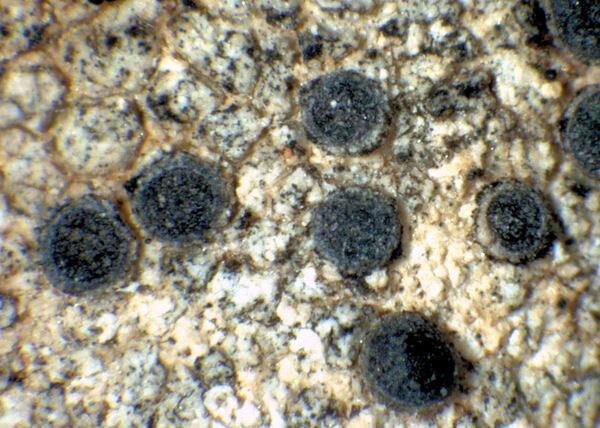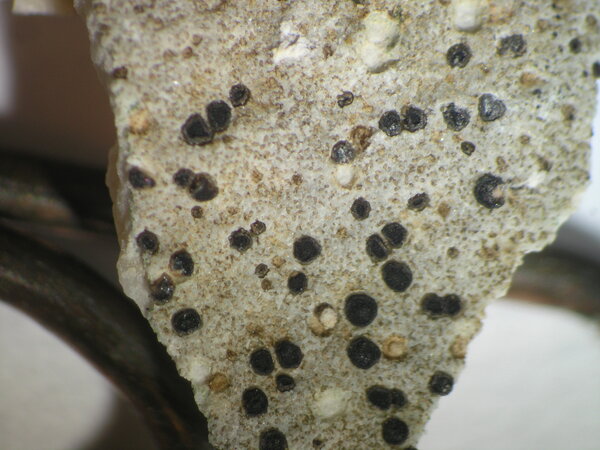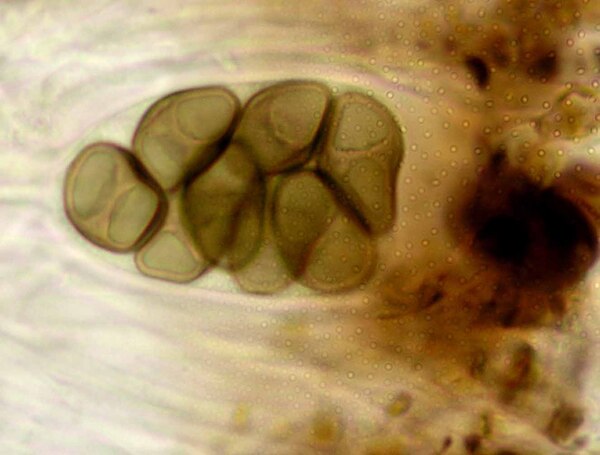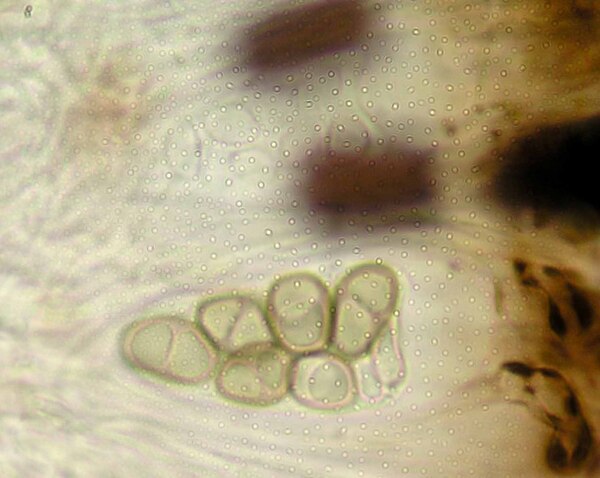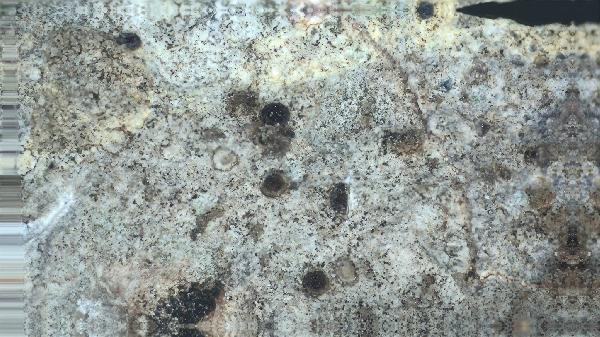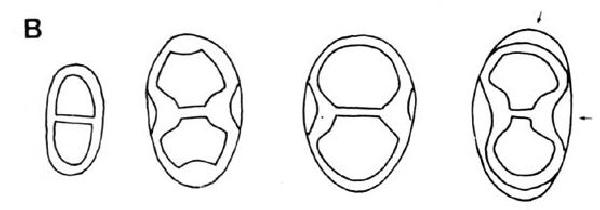Rinodina dubyana (Hepp) J. Steiner
Verh. zool.-bot. Ges. Wien, 69: 60, 1919. Basionym: Lecidea dubyana Hepp - Flecht. Eur.: nr. 322, 1857.
Synonyms: Buellia dubyana (Hepp) Rabenh.; Lecanora bischoffii var. mediterranea Stizenb.; Lecanora bischoffii var. melanops (Müll. Arg.) Stizenb.; Rinodina bischoffii var. mediterranea (Stizenb.) Flagey; Rinodina bischoffii var. melanops Müll. Arg.; Rinodina mediterranea (Stizenb.) Flagey
Description: Thallus crustose, endosubstratic or more rarely very thinly episubstratic and then whitish to pale grey, rimose-granulose, forming up to c. 1 cm wide patches. Apothecia cryptolecanorine, 0.2-0.6 mm across, immersed in the rock, then adnate to rarely sessile, with a flat to slightly convex, dark brown to black, sometimes slightly white-pruinose disc, and a thin, sometimes finally excluded proper margin; thalline margin absent or very poorly developed. Epithecium dark brown, 15-20 µm thick, K-; hymenium colourless, 60-100 μm high; paraphyses simple, 1-2 μm thick at mid-level, the apical cells 3-7 μm wide, often capitate, the apical cell with internal brown pigment; hypothecium colourless or very pale brown, up to to 100 µm high. Asci 8-spored, narrowly clavate, the K/I+ blue tholus penetrated by a faintly amyloid apical cushion with parallel or diverging flanks, the wall K/I-, surrounded by a K/I+ blue outer layer, Lecanora-type. Ascospores 1-septate, brown, ellipsoid, sometimes slightly constricted at septum, (12-)14-17(-19) x 8-10(-11) μm, Physconia-type, without a torus, the ontogeny of type A (apical wall thickening after septum formation). Photobiont chlorococcoid. Spot tests: K-, C-, KC-, P-, UV-. Chemistry: without lichen substances.
Growth form: Crustose
Substrata: rocks
Photobiont: green algae other than Trentepohlia
Reproductive strategy: mainly sexual
Commonnes-rarity: (info)
Alpine belt: absent
Subalpine belt: absent
Montane belt: rather rare
Dry submediterranean belt: rather common
Humid submediterranean belt: very rare
Padanian area: absent
pH of the substrata:
1 2 3 4 5
Solar irradiation:
1 2 3 4 5
Aridity:
1 2 3 4 5
Eutrophication:
1 2 3 4 5
Poleotolerance:
0 1 2 3
Altitudinal distribution:
1 2 3 4 5 6
Rarity
absent
extremely rare
very rare
rare
rather rare
rather common
common
very common
extremely common
Loading data...
Occurrence data
Predictive map
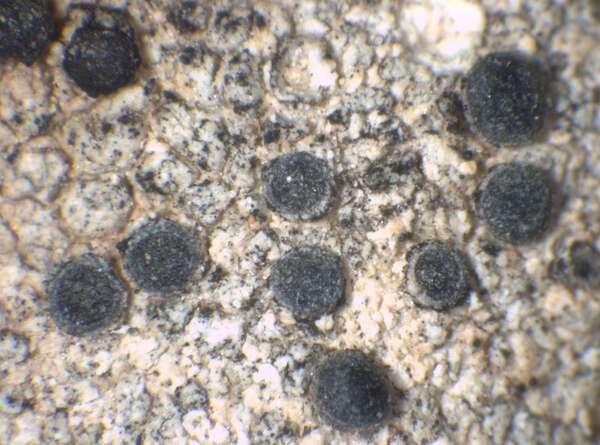
P.L. Nimis; Owner: Department of Life Sciences, University of Trieste
Herbarium: TSB (17223)
2003/03/17
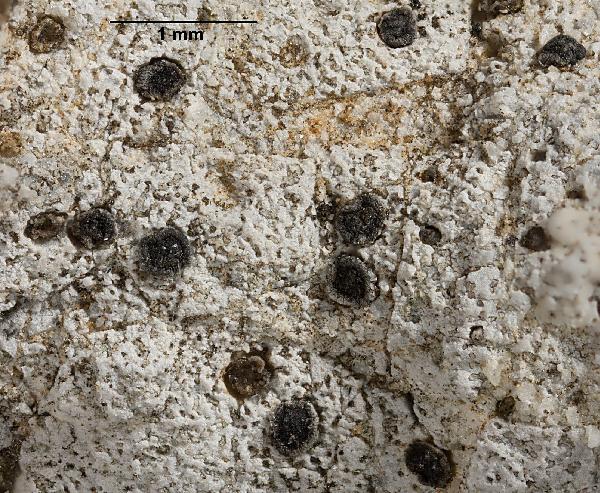
Ulrich Kirschbaum CC BY-SA 4.0 - Source: https://www.thm.de/lse/ulrich-kirschbaum/flechtenbilder
On limestone.
SE Europe; N-Cyprus; SE of Girne; Beşparmak Mountains; Antiphonitis Monastery
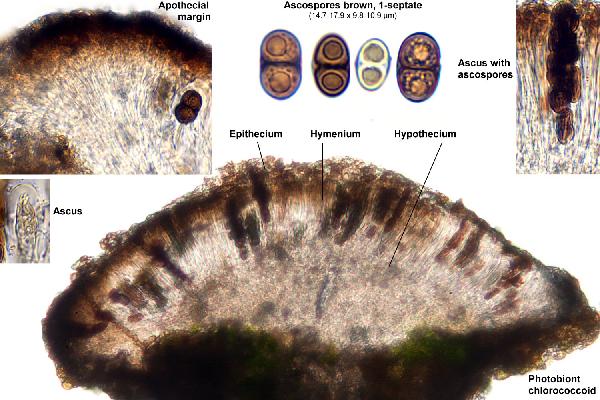
Ulrich Kirschbaum CC BY-SA 4.0 - Source: https://www.thm.de/lse/ulrich-kirschbaum/flechtenbilder
On limestone.
SE Europe; N-Cyprus; SE of Girne; Beşparmak Mountains; Antiphonitis Monastery
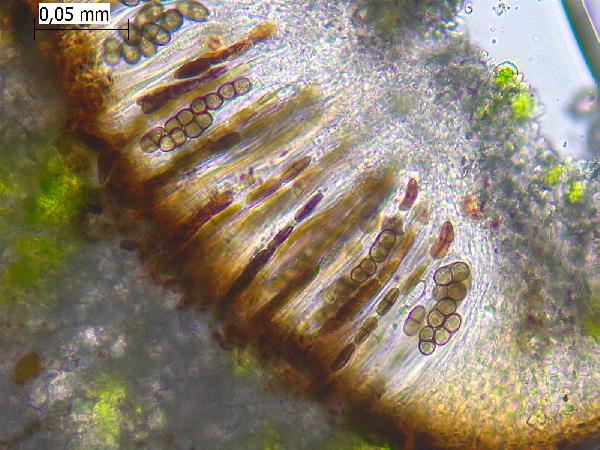
Sebastiano Dose - CC BY 4.0
TSB s.n. - ARMENIA – Vayots Dzor Province, municipality of Areni, on the rock walls along the Noravank Monastery Road, at the bottom of the Noravank gorge; on sandstone and conglomerate/calcareous rocks, ca. 105-1100 m a.s.l.
28.09.2024 leg. L. Muggia & PL. Nimis, A. Gasparyan
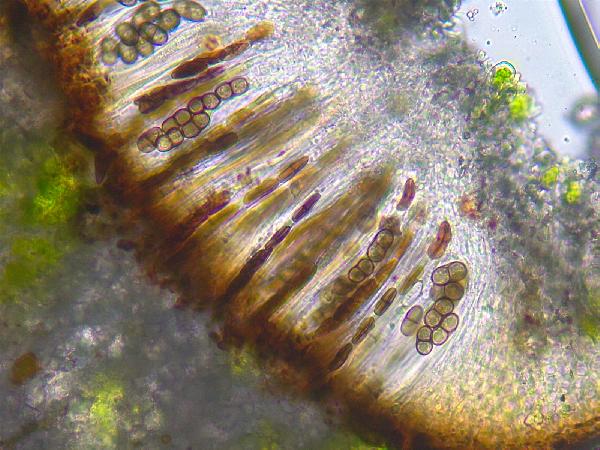
Sebastiano Dose - CC BY 4.0
TSB s.n. - ARMENIA – Vayots Dzor Province, municipality of Areni, on the rock walls along the Noravank Monastery Road, at the bottom of the Noravank gorge; on sandstone and conglomerate/calcareous rocks, ca. 105-1100 m a.s.l.
28.09.2024 leg. L. Muggia & PL. Nimis, A. Gasparyan
Growth form: Crustose
Substrata: rocks
Photobiont: green algae other than Trentepohlia
Reproductive strategy: mainly sexual
Commonnes-rarity: (info)
Alpine belt: absent
Subalpine belt: absent
Montane belt: rather rare
Dry submediterranean belt: rather common
Humid submediterranean belt: very rare
Padanian area: absent
pH of the substrata:
| 1 | 2 | 3 | 4 | 5 |
Solar irradiation:
| 1 | 2 | 3 | 4 | 5 |
Aridity:
| 1 | 2 | 3 | 4 | 5 |
Eutrophication:
| 1 | 2 | 3 | 4 | 5 |
Poleotolerance:
| 0 | 1 | 2 | 3 |
Altitudinal distribution:
| 1 | 2 | 3 | 4 | 5 | 6 |
Rarity
absent
extremely rare
very rare
rare
rather rare
rather common
common
very common
extremely common
Loading data...
Occurrence data
Predictive map

P.L. Nimis; Owner: Department of Life Sciences, University of Trieste
Herbarium: TSB (17223)
2003/03/17

Ulrich Kirschbaum CC BY-SA 4.0 - Source: https://www.thm.de/lse/ulrich-kirschbaum/flechtenbilder
On limestone. SE Europe; N-Cyprus; SE of Girne; Beşparmak Mountains; Antiphonitis Monastery

Ulrich Kirschbaum CC BY-SA 4.0 - Source: https://www.thm.de/lse/ulrich-kirschbaum/flechtenbilder
On limestone. SE Europe; N-Cyprus; SE of Girne; Beşparmak Mountains; Antiphonitis Monastery

Sebastiano Dose - CC BY 4.0
TSB s.n. - ARMENIA – Vayots Dzor Province, municipality of Areni, on the rock walls along the Noravank Monastery Road, at the bottom of the Noravank gorge; on sandstone and conglomerate/calcareous rocks, ca. 105-1100 m a.s.l. 28.09.2024 leg. L. Muggia & PL. Nimis, A. Gasparyan



